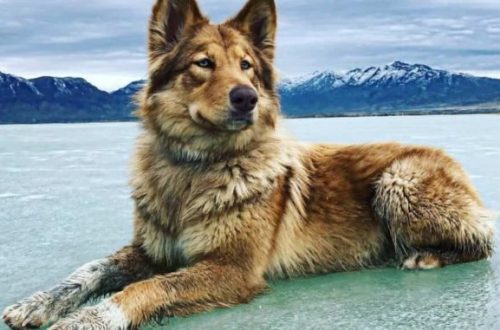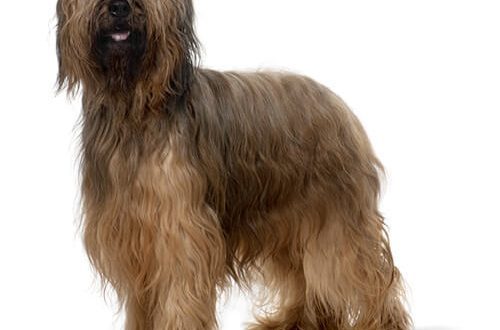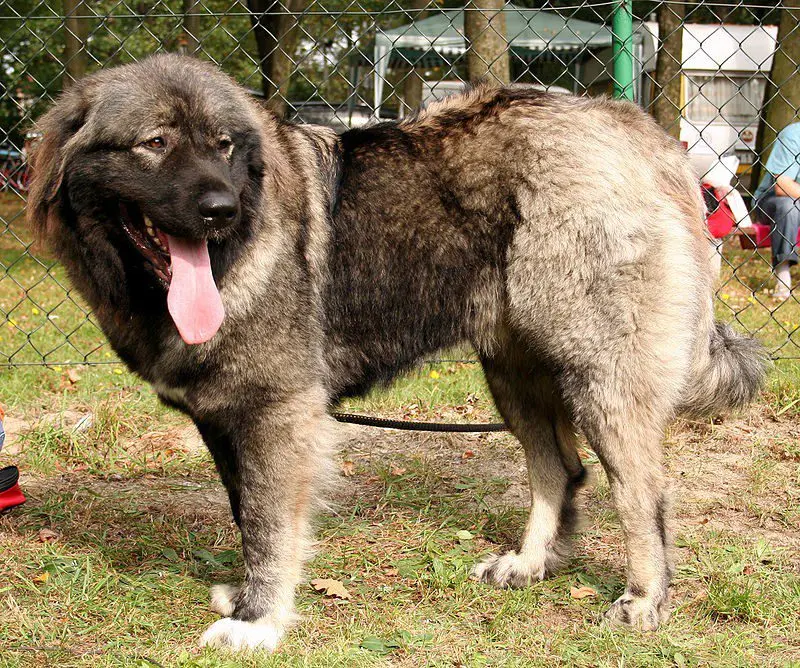
Caucasian Shepherd Dog
Other names: Caucasian , Caucasian mountain dog , Caucasian wolfhound
The Caucasian Shepherd Dog or the Caucasian Wolfhound is a breed of large guard dogs with a determined, fearless character. They do an excellent job of shepherding and security activities. Allotted to one owner.
Contents
- Characteristics of Caucasian Shepherd Dog
- Basic moments
- The history of the Caucasian Shepherd breed
- Video: Caucasian Shepherd Dog
- Appearance of the Caucasian Shepherd
- Photo of an adult Caucasian Shepherd Dog
- The nature of the Caucasian Shepherd Dog
- Education and training
- Care and maintenance
- Health and disease of Caucasian shepherd dogs
- How to choose a puppy
- Photos of caucasian shepherd puppies
- How much does a caucasian shepherd dog cost
Characteristics of Caucasian Shepherd Dog
| Country of origin | USSR |
| The size | large (very large) |
| Growth | 66–75 cm |
| Weight | 45–75 kg |
| Age | 9–11 years old |
| FCI breed group | pinschers and schnauzers, molossians, mountain and swiss cattle dogs |
Basic moments
- Caucasian Shepherds are friendly only towards members of the family in which they live. All unfamiliar people and animals are viewed through the prism of distrust.
- Dogs have lightning fast reactions. Always ready to stand up for the owner and his property.
- Caucasian wolfhounds are not bloodthirsty, but quite aggressive, so they need a firm hand. People who do not have the skills to educate and train guard dogs should think more than once before acquiring a “Caucasian”.
- Sheepdogs are phenomenally sensitive. A sleeping pet is able to catch the slightest rustles and noises.
- Dogs tolerate cold relatively easily, so they feel great in an aviary and booth.
- Caucasian Shepherd Dogs are calm about the owner’s absences and do not require special attention to themselves. They can sit for hours, taking a wait-and-see attitude and looking out for potential border violators.
- Representatives of the breed grow slowly, reaching full physical and mental maturity only by 2 years.
- Dogs are smart and trainable, although they are inferior to German Shepherds in the speed of mastering basic commands.
- Caucasian Shepherd Dogs are easily turned on and uncontrollable in anger. The raging “Caucasian” is able to pretty much fray the skin and nerves of even the most eminent representative of fighting breeds.
- Animals have good intuition and easily determine “by eye” the degree of possible danger.
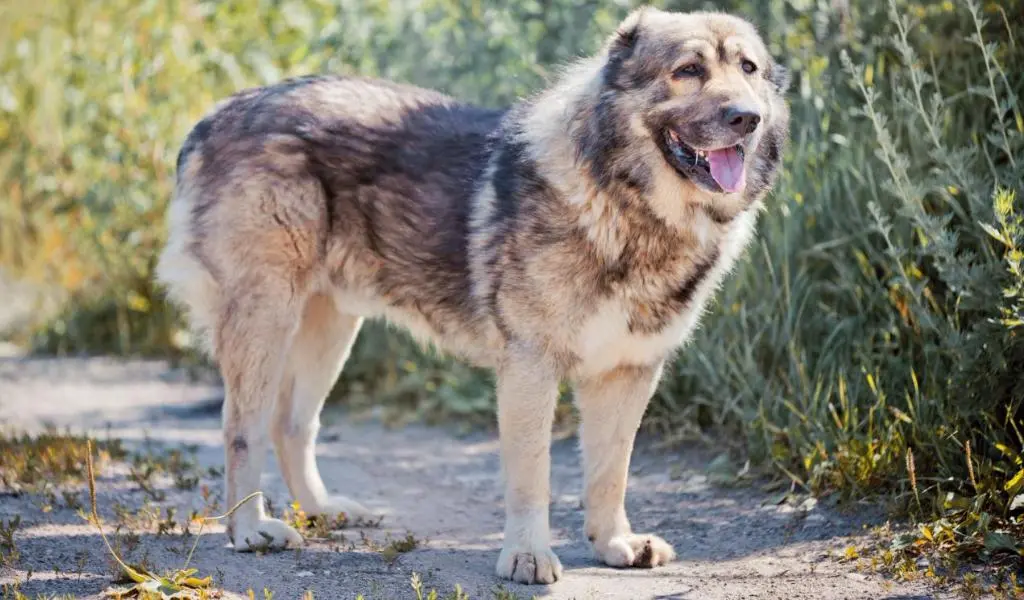
Caucasian Shepherd Dogs are the nightmare of all hooligans and property hunters. Soft on the outside and harsh on the inside, these formidable giants have a number of virtues, among which the central place is the willingness to stand up for the owner and his material values. But one should not expect special emotionality, as well as compliance, from Caucasians. Any wolfhound is, first of all, a watchman and a security guard, with an explosive character and his own outlook on life, and only secondly is a pet.
The history of the Caucasian Shepherd breed
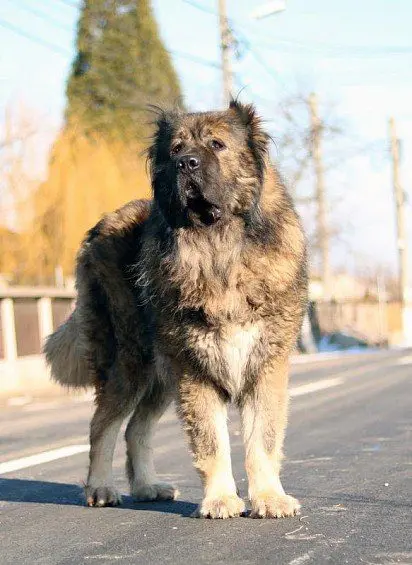
Caucasian Shepherd Dogs are among the oldest canine “clans”, the history of which is thousands of years old. So, for example, the ancestors of today’s wolfhounds grazed sheep flocks in the foothills of the Caucasus long before the advent of Christianity. As for the origin of the breed itself, its founders are Tibetan Great Danes, which in ancient China were used for harassment and fighting. Some experts call the homeland of dogs southwestern Asia, or rather, the Urartu-Ararat kingdom, where animals were in the service of pastoralists and from where they began to disperse to adjacent territories.
An interesting fact: the first “breeders” to whom the Caucasian Shepherd Dogs owe their outstanding watchdog instinct were ancient shepherds. It was they who were in charge of the mating of animals and the selection of puppies, cultivating and successfully developing useful working characteristics in them. For example, a real shepherd dog, in the understanding of the Caucasian shepherds, had to have endurance and sufficient strength to deal with an attacking wolf. In addition, she was prescribed unpretentiousness in food and insensitivity to a sharp change in air temperature.
The impetus for the appearance of shaggy “highlanders” in tsarist Russia was the Caucasian War. Participants in the hostilities brought dogs as live trophies, while none of the newly-made owners of shepherd dogs was eager to seriously engage in breeding the breed. Domestic breeders began to be interested in wolfhounds only in the 30s of the last century, after the Nuremberg exhibition, but their breeding research was interrupted by World War II, which destroyed the entire gene pool of Caucasians. More or less, it was possible to restore the breed in the USSR only by the beginning of the 70s. From about that time, consumer demand also began to grow for Caucasian Shepherd Dogs.
Video: Caucasian Shepherd Dog
Appearance of the Caucasian Shepherd
What Caucasian Shepherd Dogs cannot be blamed for is the lack of charisma and external charm. Indeed, the muscular “highlanders” look very solid, if not monumental. Long-haired individuals look especially colorful, having lush, almost bearish “fur coats”, giving the animals a resemblance to gigantic toys.
The minimum weight of a purebred male Caucasian wolfhound is 50 kg. However, most dogs do not stop at such modest indicators, often overcoming the bar of 70, and sometimes even 100 kg. Shepherd females are lower and slimmer than males: the minimum allowable weight of a girl is 45 kg, with a height of 64 cm or more. But, as in any rule, there are exceptions here too.
Head
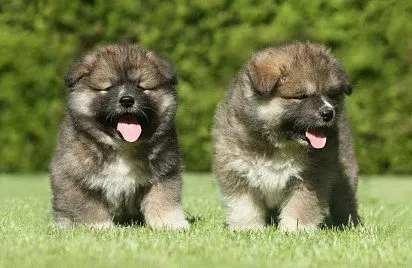
Wedge-shaped, with a flat forehead and prominent cheekbones. The skull of the Caucasian Shepherd Dog looks massive, but the superciliary arches and the occipital protuberance in representatives of this breed are weakly expressed. The muzzle is broad, tapering smoothly from the base to the nose, and ends in a strong chin. The stop is noticeable, but without a sharp transition.
Lips
Dry, fleshy, with good pigmentation.
Teeth
Massive, white, incisors are located close to each other. Both scissor and level bite types are acceptable. It is desirable to have a complete set of teeth (42).
Nose
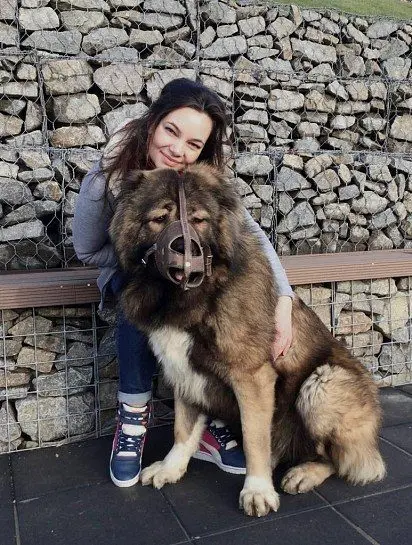
The back of the nose is even, wide, with a large lobe that does not extend beyond the muzzle. Nostrils open moderately. Ideally, the earlobe should be black, but an exception can be made for individuals with piebald and spotted coat colors.
Eyes
Caucasian Shepherd Dogs have rounded eyes, located slightly obliquely and at a sufficiently large distance from each other. The look of the representatives of this breed is attentively focused, evaluating. The colors of the iris fixed by the breed standard are all shades of brown, including dark brown and light hazel variants.
Ears
Small, hanging type and high set. The ear cloth is densely muscular with the inner part pressed against the head. Both cropped and natural ear shapes are allowed.
Neck
Not short, dense, with a developed nape.
Frame
The body of the Caucasian Shepherd Dog is large, elongated, with a broad back, a short loin and a taut belly. The croup is slightly rounded, elongated, with a slight slope at the base of the tail. The chest is deep, noticeably stretched in breadth.
Tail
Crescent, set high. In a calm animal it hangs down, reaching the hocks, in an excited animal it is raised above the line of the back.
limbs
Fore and hind legs set straight. Wide, pressed to the body shoulder blades pass into strong, muscular shoulders. Pasterns large and short. The hips of the Caucasian Shepherd Dogs are strong, “pumped up”. The hocks are dry, wide and strong. The paws of all four limbs are large, arched type, with fingers compressed into a ball.
Wool
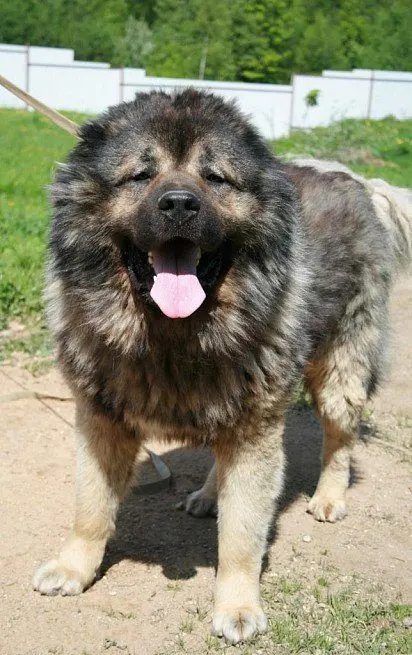
Rigid, noticeably lagging behind the body hair with a pronounced undercoat. The average length of the awn and undercoat is 5 cm. On the ears, the hair forms amusing tassels, and in the chest area it turns into a chic mane. On the back side of the front paws, the hair gathers into long feathers, the dog’s thighs are hidden under soft downy “panties”. The tail is profusely covered with hair, which makes it seem thicker than it actually is. Depending on the length and structure of the coat, three types of Caucasian wolfhounds are distinguished:
- smooth-haired;
- long-haired;
- intermediate.
Among buyers, individuals of the second type are in high demand. Of the entire tribe of Caucasian Shepherd Dogs, it is they who have the most striking and memorable appearance. Representatives of the first variety are easily confused with Alabai because of the short undercoat and similar physique.
Color
All types of piebald, solid and spotted colors are allowed, with the exception of any combination of black.
Possible vices
Caucasian Shepherd Dogs are considered defective, whose anatomical features do not fit into the official standard. An animal may be disqualified from competitions if it has the following malformations:
- cryptorchidism;
- insufficient growth (dwarfism);
- non-standard bite;
- brown-brown color and any of its variations;
- blue and black coat colors, as well as any combination thereof;
- docked tail;
- blue or grayish tint of the eyelids, lobes and lips;
- entropy;
- eyes of different shades, as well as uneven color;
- missing one or more teeth (exceptions: third molars and first premolars);
- brown tint of the eyelids, lips and nose.
Photo of an adult Caucasian Shepherd Dog
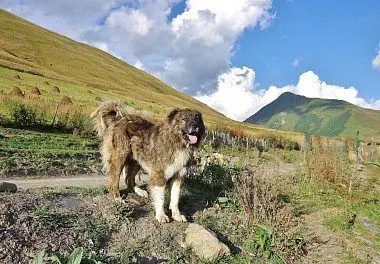
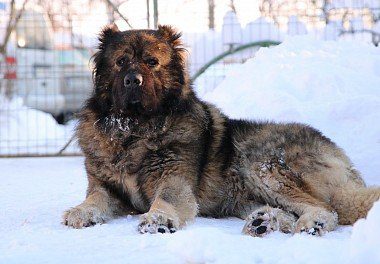
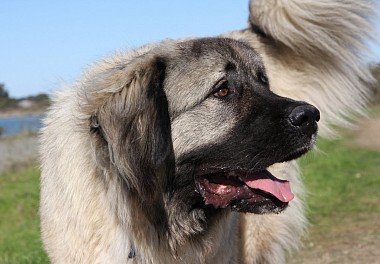
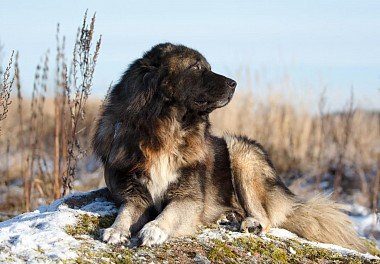

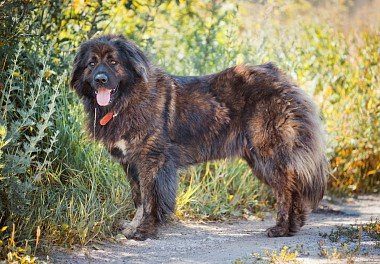
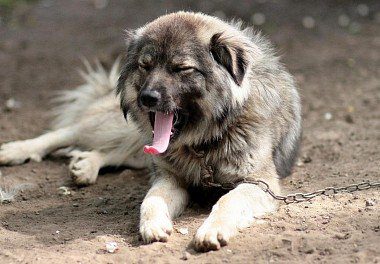
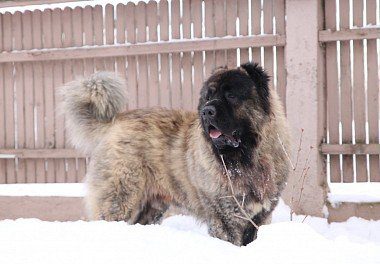

The nature of the Caucasian Shepherd Dog
Having a rather pleasant, and sometimes frankly touching appearance, Caucasian wolfhounds remain very serious pets, the owners of which will have to constantly keep their finger on the pulse. These harsh brutals are focused on protecting a person and his property. Not a single stranger, even the most insinuating manners, will be able to ingratiate themselves with them. Intimidation and treats do not work on dogs either, so if you are looking for a first-class watchman with the makings of a professional bodyguard, the brave “highlanders” will not disappoint you.
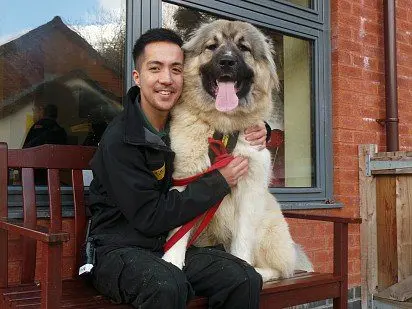
Caucasian Shepherds slightly “thaw out” only when they are in the circle of their favorite people, which in general is not surprising. Endless devotion to home and family is one of the key characteristics of this canine tribe. True, in order to earn the pet’s trust, you will have to work hard on the image of a strict and fair owner, since the cult of power for shaggy “security” is not an empty phrase.
Most Caucasian Shepherd Dogs are smart, balanced and quite adequate pets, with a hardened character. So, for example, they willingly spend time with children, taking part in their games and tricks. However, do not try to raise an all-forgiving nanny from a shaggy guard: the work of a shepherd dog is to protect a person, and not to serve him as fun.
Despite the natural severity, the “Caucasians” are not averse to sharing the territory with some domestic animals. As for living with other dogs, a representative of any of the decorative breeds will be the best company for a shepherd dog. The miniature dimensions of a four-legged creature are a kind of guarantee of the peaceful coexistence of pets, while in a larger individual, the Caucasian wolfhound will immediately feel an opponent whom he will try to crush under him.
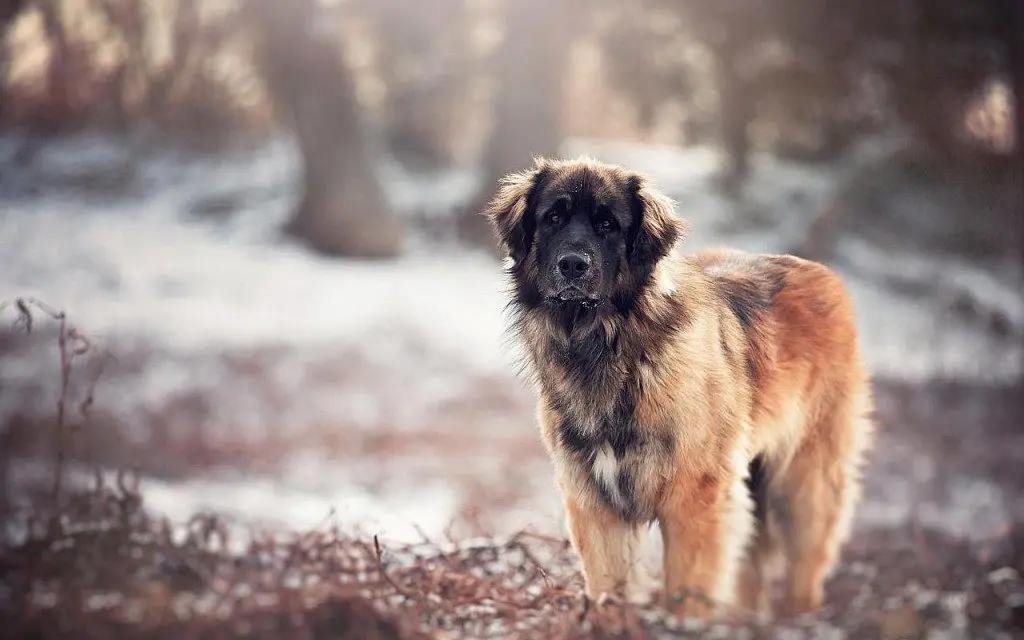
Education and training
There are many myths about the bloodthirsty nature of the Caucasian Shepherd Dogs. It is important to understand that no dog is born a killer. But it may well become her as a result of improper upbringing. An owner who neglects to train and socialize a pet and is unable to maintain his own authority risks raising an uncontrollable and ferocious creature, which he will eventually have to part with. In addition, when bringing a small puffy puppy into the house, not every buyer is aware of who this cutie will transform into in a year. Keep in mind that growing up, Caucasian wolfhounds completely get rid of “childish” character traits, turning into self-confident and rather stubborn guardians.
The upbringing and socialization of a puppy begins from the very first days of its appearance in the house. Particular attention should be paid to individuals living in the city. The dog should not be afraid of public transport, growl at every passer-by and chase stray cats. Since Caucasian Shepherd Dogs are slow-growing breeds, they begin to train their first teams at the age of 5-6 months. By the year the animal must understand and execute the following commands:
- “No!”, “Fu!”;
- “Sit!”, “Stand!”, “Lie down!”;
- “Beside!”;
- “Teeth!”;
- “Muzzle!”;
- “Place!”;
- “To me!”.
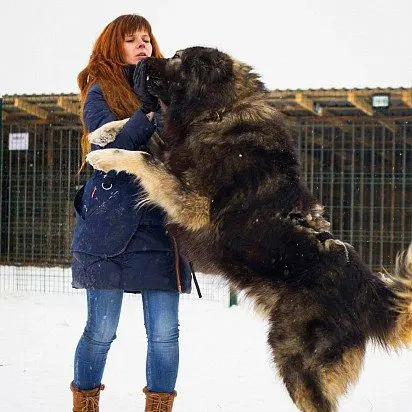
The Caucasian Shepherd Dog is a personality dog, so do not try to persuade her to useless running errands for a thrown ball or plate. Such activities cause the animal to feel bewildered: why waste energy if it can be saved up for a possible throw at the enemy? Congenital stubbornness and a high level of intelligence prevent Caucasian wolfhounds from completely immersing themselves in the learning process. Surprisingly, but a truly effective method of training shaggy “highlanders” has not yet been invented. Moreover, with them, even the standard OKD (General Training Course) gives very inexpressive results.
The qualities that the owner of a Caucasian shepherd dog will need in the process of training a pet are patience and endurance. In addition, it is necessary to establish close emotional contact with the animal, since representatives of this breed are distinguished by a developed intuition and easily determine the mood of the owner by his facial expressions and voice. Do not be surprised, but the training of the Caucasian Shepherd Dog can take 2-3 years due to the dog’s dislike for repetitions. And the point here is not the complexity of nature. The animal simply does not see the point in the monotonous repetition of the same exercise, because it is much more reasonable to save energy for more interesting activities.
Do not be fooled by the advice of “experienced” dog lovers who claim that Caucasian shepherd dogs must be beaten periodically so that they understand who is “the boss in the house.” You will achieve nothing but anger and uncontrolled aggression in this way. Yes, it is necessary to treat a pet strictly, and sometimes quite severely, but applying corporal punishment to it is the last thing. Bribing with sweets and caresses in a particular case is also not good. Sheepdog is not a vulnerable lap dog and she does not need your concessions.
Like most dogs of large breeds, Caucasian wolfhounds have a tendency to dominate, so it is important to catch the moment when the animal begins to show leadership habits in order to further correct its behavior. It is not difficult to understand that your pet has gained strength and is preparing to crush the household under him. Usually such a dog begins to neglect the rules of etiquette: beg for food; run into the house ahead of the owner; walking on a leash, breaking free and dragging a person along. Some individuals show aggression, growling at family members.
The specifics of training the Caucasian Shepherd Dog ZKS
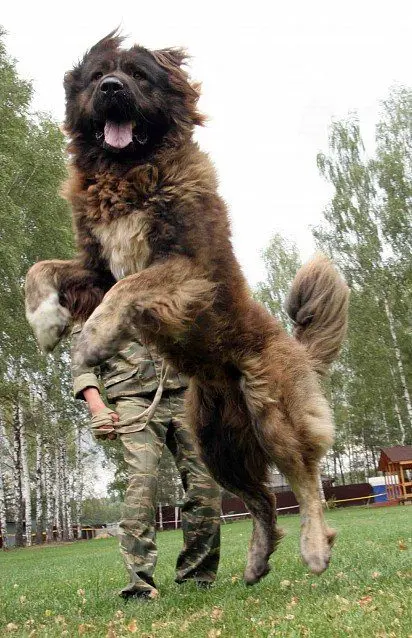
Whatever the advertising of cynological schools promises, the ZKS courses for the Caucasian Shepherd Dog are pure formality. These harsh giants are born watchmen and bodyguards, and they do not need to be taught the correct reaction to any “alien” who violated the boundaries of the master’s possessions. If you still want the dog to comprehend the intricacies of guard duty, get ready for the fact that during the training your pet will not always show brilliant results. So, for example, an animal can simply ignore the provocation from the trainer and this behavior is explained simply: the dog does not see the need to resist the fake threat.
Ideally, ZKS training is carried out in the territory that the pet considers his own. Training on playgrounds and wastelands disorients the dog. The animal does not understand why guard an uninteresting and completely unfamiliar place that does not belong to him. In addition, many of the skills instilled in the ZKS course contradict the nature of the Caucasian Shepherd Dogs. In particular, most wolfhounds do not pursue an enemy who has taken flight, but protective guard duty requires the opposite from the animal.
Caucasian Shepherd Dogs also do not like to practice skills on a sleeve stuffed with cotton, preferring to bite into the open areas of the instructor’s body, which is why many cynologists do not undertake to work with the breed. A disturber of the peace, encroaching on the health of the owner or his property, the wolfhounds do not grab with their teeth, but fully tear, and it will take titanic efforts to wean them from this habit. At demonstration competitions, dogs can also be cunning and turn on the energy saving mode. Such half-hearted work indicates that the animal has managed to appreciate the frivolity of what is happening and does not consider it necessary to give all the best for the sake of some kind of assessment.
Care and maintenance
The Caucasian wolfhound is a terrible owner who is truly happy only when he has something to protect. Accordingly, the best home for a pet would be a cottage with a courtyard and a plot of land. These shaggy brutals are not sensitive to temperature changes, so they feel quite comfortable in a spacious aviary. Keeping Caucasian Shepherd Dogs on a chain is also quite acceptable, but it should be a light chain up to 2.5 m long.
Settling a “Caucasian” in a city apartment is an extreme for a very big fan, who is practiced only by the most stubborn lovers of the breed. Yes, shaggy watchmen do not suffer from hyperactivity and do not arrange pogroms, but they cannot fully realize their security qualities in such conditions. Do not discount the complexity of placing a pet. The Caucasian Shepherd Dog is a large breed and its representatives need decent places. It is not enough to provide the dog with a spacious bed and a bowl for food, it is also necessary to provide an excellent overview of the premises entrusted to it. In addition, when opening the door to each guest, the owner will have to carefully monitor the reaction of his pet: a stranger who crossed the threshold of private property is enemy No. 1 for shaggy bodyguards.
Hygiene

You don’t have to be a cynology guru to understand that long-haired Caucasian Shepherd Dogs require more care than their short-haired counterparts. The soft hair of shaggy individuals gets tangled, and in winter it absorbs snow moisture, so long-haired wolfhounds are periodically combed and trimmed (the hair on the legs and paws is shortened). Shepherd dogs are washed as needed, for example, when the animal gets dirty in the mud or has acquired blood-sucking “tenants”. At the same time, it is better not to refuse dogs swimming in open water, especially since swimmers from them are excellent.
In spring and summer, “Caucasians” suffer from ear mites, so ear funnels in the warm season need to be inspected and cleaned more often. If the animal shakes its head and scratches its ears, contact your veterinarian who will sort out the problem. Perhaps it is not ticks that are to blame, but otitis media.
The eyes of Caucasian Shepherd Dogs are problem-free, but some individuals have a congenital pathology in the form of a loose eyelid. As a result: an infection from the outside gets into the eyes, causing inflammation. You can fight the problem with a decoction of chamomile or veterinary drops.
“Caucasians” like to gnaw bones at their leisure, and even wooden boards, the remains of which get stuck between their teeth. So buy tweezers in advance, with which you will free your pet’s jaws from solid particles of food and wood. To remove plaque, which periodically appears in each dog, you can use a special brush and veterinary paste.
Ear cropping
Previously, the ears of Caucasian shepherd dogs were subject to mandatory cropping. The procedure was carried out far from aesthetic purposes. In this way, ancient breeders tried to protect their pets from blood loss, because the longer the ear, the greater the risk of injuring the animal in a fight. Today, this requirement has been removed, but for old times’ sake, most nurseries continue to practice this surgical operation.
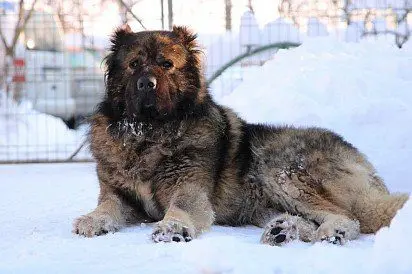
The ideal age for cupping the ears of a Caucasian wolfhound is the first days of life. On the 5th day after birth, the ear cloth thickens, and it becomes more difficult and dangerous to work with it, since there is a risk of blood loss. Owners who have acquired a puppy with normal ears, but would like to stop them, are better off waiting until the dog is one year old. At this age, the animal is able to endure general anesthesia, under which the procedure is usually performed.
Important: do not play doctor-know-it-all and do not try to cut the ears of a Caucasian shepherd dog yourself. Each animal has a unique shape, thickness and size of the ear, so only a veterinarian or an experienced breeder can determine the principle of “cutting” this part of the body.
Paddock
Walking “Caucasians”, of course, is necessary, but spending half a day with them on the street is not at all necessary. Keep in mind that too long promenades are not a joy for shaggy security guards, as they prefer to save their energy for more serious matters. In crowded places, in a veterinary clinic and public transport, a muzzle is required. Dogs do not favor this accessory, so it is better to accustom pets to it from puppyhood. For outings, the Caucasian Shepherd Dog will need two leashes: a short one (from 1 to 1.5 m) to keep the animal at the owner’s feet, and a long one for walking itself.
Rules for walking the Caucasian Shepherd Dog
- The dog is taken outside only on a short leash and in a muzzle.
- It is strictly forbidden to walk Caucasian Shepherd Dogs by children under the age of 14, as well as by persons who are in a state of drug and alcohol intoxication.
- If the animal walks in a private fenced area, passers-by must be notified about this. The inscription: “Beware of the angry dog!”, Attached at the entrance to the territory, will do.
Feeding
Compared to representatives of other large breeds, Caucasian Shepherd Dogs are small. 35-45 g of natural food or 10-15 g of “drying” per kilogram of animal weight – this is the daily intake of food for an adult. Shepherd dogs have a high metabolism, which allows them to “squeeze” the maximum of nutrients from a relatively small portion. In addition, their digestive system perfectly absorbs milk, a product that can provoke intestinal upset in most dogs. Here, however, it is worth making an explanation: only those individuals who have been accustomed to it are able to digest whole milk. If such food did not appear on the “table” of the dog for several months, and then unexpectedly returned, get ready for diarrhea.
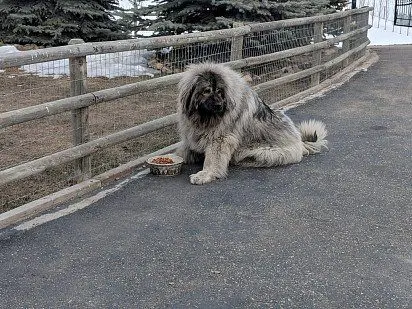
The most important product in the diet of the Caucasian Shepherd Dog is meat, and its coarse varieties: horse meat, lean beef, lamb. Offal and fish (mackerel, horse mackerel) are also not excluded. It is supposed to dilute animal proteins with cereals, as well as fruits and vegetables. Cereals (mainly rice and buckwheat) must be thoroughly boiled, otherwise the dog’s stomach will not cope with them. You can cook cottage cheese for your pet: heat a liter of milk on the stove and add 4 tbsp. l. calcium chloride. Apple and carrot salads with oil and banana puree are suitable as vitamin supplements.
In food, Caucasian shepherd dogs are picky and willingly absorb everything that the owner gives them. Experts recommend not accustoming a dog to a special variety of food and delicacies, since representatives of this breed are extremely economical in energy consumption and do not always have the opportunity to “burn” extra calories. So if your pet has begun to suffer from loss of appetite, do not be alarmed and do not try to force-feed him. It’s just that the dog decided to arrange a fasting day, thus getting rid of the excess energy reserve.
Health and disease of Caucasian shepherd dogs
Caucasian Shepherds are a healthy and hardy breed with good immunity. Of the genetic diseases, they are seriously annoyed only by hip dysplasia and optic nerve atrophy. Slightly less commonly, dogs are diagnosed with bursitis and degenerative myelopathy. Viral infections should not be discounted, to which individuals in captive keeping are especially susceptible.
Due to a sedentary lifestyle and lack of physical activity, many older animals put on excess fat, which ultimately leads to diabetes. Lack of physical activity can play a bad joke on the joints of the Caucasian Shepherd Dog, provoking the development of arthritis.
How to choose a puppy
Immediately decide who exactly you need: a pet, a watchman and a bodyguard, or a future successor to the Caucasian Shepherd Dog family. If you are planning to adopt a pet in a home with children, it is better to opt for bitches that are more good-natured and more willing to learn. But keep in mind that “for health” the girl will have to be allowed to have offspring at least once.
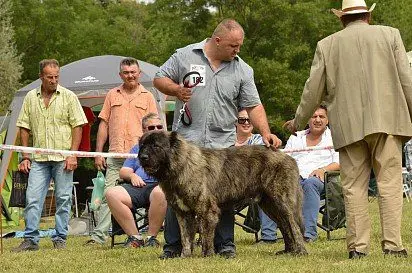
Caucasian Shepherd dogs make excellent guards. But since the character of the boys is more powerful, it is easier for them to crush the inexperienced owner under them. So, before you settle a shaggy male brutalist in your house, think carefully about whether you have enough endurance and strength to raise a defender out of him, and not a ferocious aggressor.
When choosing a future watchman in the nursery, pay attention to his behavior. Active and contact puppies have the maximum potential. Wayward leaders grow out of cocky and pugnacious kids, and only a strict owner can curb their temper. Keep your puppy in mind as well. Animals that have been kept in the right conditions should not show signs of inguinal or umbilical hernia. Cropped ears and the absence of dewclaws are signs that the breeder is responsible for his occupation and monitors the health of his wards.
Note: You can check the condition of a Caucasian Shepherd puppy with a simple test. Bring a piece of raw meat to the nose of the dog – a healthy pet will instantly react to this action and try to grab a treat.
Photos of caucasian shepherd puppies
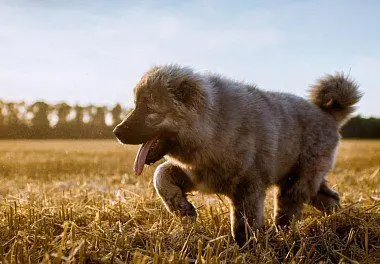
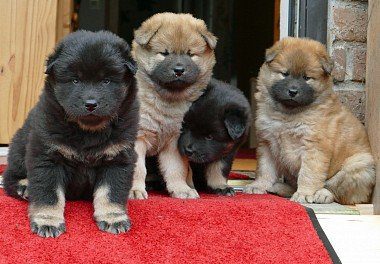

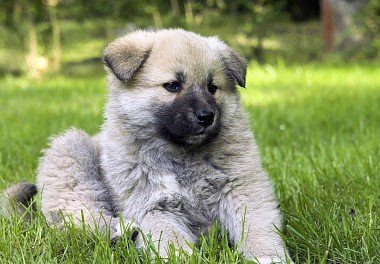
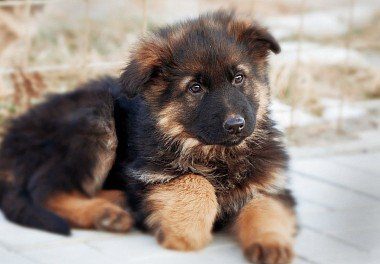
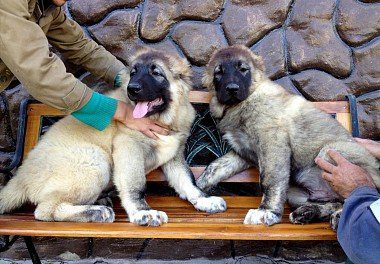
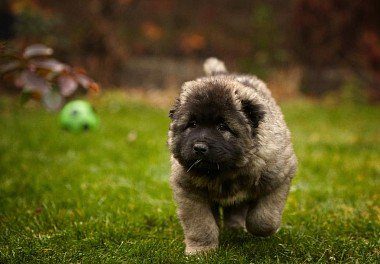
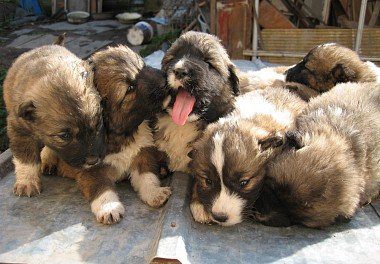
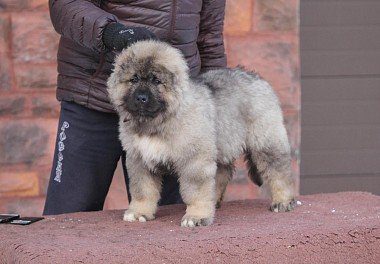
How much does a caucasian shepherd dog cost
The cost of an average Caucasian Shepherd puppy ranges between 400$ and 500$. Offspring from parents who have made an exhibition career will cost one and a half to two times more – 800$ – 1000$. The cheapest options are offered by virtual bulletin boards like Avito: on average, from 100 to 200$.



